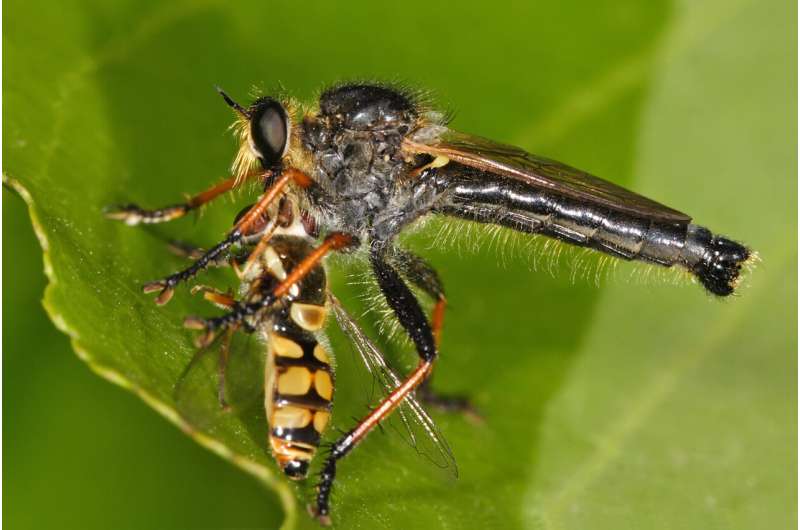
Posted on 02/16/2022 12:24:28 AM PST by LibWhacker

Robber flies snatch victims from the air using the same interception strategy as guided missiles and falcons, but how do they intercept airborne quarry when their view is obstructed by foliage and clutter? Researchers from the University of Cambridge, UK, and the University of Minnesota, U.S., report in Journal of Experimental Biology that Holcocephala fusca robber flies combine two strategies, one that allows them to swerve around obstructions, with their usual strategy to intercept prey.
While many flies are content to land on pieces of fruit or carrion, robber flies (Asilidae) engage in mortal combat. Intercepting smaller insects on the wing, robber flies dine on anything they can subdue. When the view is clear, the aerobatic insects maintain the same line of sight—adjusting it as their target twists and turns—to intercept their quarry; and they do so at extraordinary speed with a brain the size of a grain of sand. Yet the dogged insects often have to seize prey in complex cluttered environments. "Navigating to targets and avoiding bumping into things along the way are tasks that we would hope to achieve in our everyday lives," says Samuel Fabian from Imperial College, London. So how do robber flies cope with clutter? Fabian, Trevor Wardill and Paloma Gonzalez-Bellido from the University of Minnesota, U.S., decided to find out how the predatory robber insects adjust their interception strategy to deal with distractions. They publish their discovery that the insects combine two strategies—one, that allows them to swerve around obstructions, with their conventional interception strategy, which they use when the view is clear—in Journal of Experimental Biology.
"We used Holcocephala fusca because of its predictable interception path," says Fabian, who joined Mary Sumner from the University of Minnesota, in York County, PA, U.S., for four intensive weeks to film the determined flies in 3D while they hunted a tiny bead being pulled along a transparent fishing line. "Field experiments are a joy, because you get the most naturalistic behavior from free animals," says Fabian. Although this meant that the insects were free to move out of shot just when the cameras were ready to roll. Fortunately, they were also keen to intercept the moving bead; "if something is small enough, they generally seem to assume it's food," says Fabian. And when he and Sumner analyzed the insects intercepting the bead, the animals maintained the same line of sight to the target throughout their approach to successfully capture it. "The flies really didn't know it's not real prey, even when very close," chuckles Fabian.
However, when Fabian and Sumner partially obscured the flies' views, with either a wide (5 cm) or narrow (2.5 cm) bar of black acrylic, as they approached the moving bead, the flies took evasive action and even abandoned the interception when the broader band obscured their view for more than 0.1 s. Yet, when the bar blocked their line of sight for briefer periods, the flies veered away dramatically until they had passed it, before swerving back and resuming their interception course. On other occasions, when the visual obstacle remained in sight but did not obscure the fly's view, the insect still veered away from the bar as they approached the bead, even though there was no need to swerve as the bead remained in sight the entire time.
So how was the fly controlling its approach? Fabian, Gonzalez-Bellido and Wardill compared the robber flies' flight paths and the paths they would have taken if there was no obstacle, and realized that the flies were using a very simple obstacle avoidance strategy; 'the faster the obstacle is getting larger in their field of view the more they turn away from it," Fabian explains. However, once the fly has passed the obstacle and it begins to grow smaller, the fly is then drawn back toward it, resulting in the veering flight paths that Fabian and Sumner recorded, even when the fly's view wasn't obstructed.
The flies are simultaneously using a combination of the obstacle avoidance strategy and the conventional interception paths used when their view is unobstructed, resulting in a simple hybrid approach that allows them to intercept their prey while avoiding distractions and obstacles in their paths. "They are paying attention to their surroundings even when focused on the target," Fabian concludes, who hopes to inspire robotic designs that use simpler and more computationally lightweight solutions for complex navigation problems.
Disclaimer: Opinions posted on Free Republic are those of the individual posters and do not necessarily represent the opinion of Free Republic or its management. All materials posted herein are protected by copyright law and the exemption for fair use of copyrighted works.